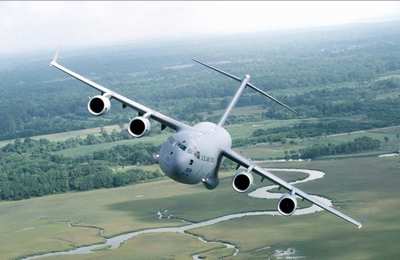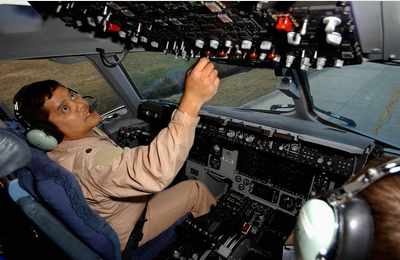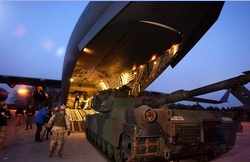The airlift armada flying into Bashur Airfield in northern Iraq
for the past two weeks has dropped off more than 10 million pounds
of cargo bound for coalition forces. More than 170 C-17 Globemaster
III and C-130 Hercules flights have brought in the cargo. The
planes land day and night and the rumble of their engines rock this
sprawling camp.

Master Sgt. Gerritt McCrory, the superintendent of mobile aerial
port operations for the 86th Expeditionary Contingency Response
Group, has a primary concern: that his 25 troops can control
airfield operations in total darkness. Most of the aircraft land at
night. The airmen who meet the aircraft, including aerial port,
aircraft maintenance and command and control troops, do their job
wearing night-vision goggles.
"Under night vision you have no depth perception. So pulling up
to an aircraft in pitch black can be dangerous," McCrory said.
"Plus the aircraft are all doing engines-running offloads. That
adds more pressure because we have to offload them as fast as
possible so they can get out of town."
During the past two weeks, McCrory's team has not suffered any
injuries or damaged any aircraft, despite turning aircraft in from
five-to-15 minutes.
"We're proud of that," McCrory said. "Not many units can perform
at that level -- all the time -- while wearing night vision
goggles."

The planes have brought in almost all the troops, equipment,
supplies and food needed to sustain coalition forces in northern
Iraq. And there is no end in sight for the massive airlift, he
said. The intensive bombing campaign of Operation Iraqi Freedom has
not damaged the base's long runway. It is the only runway capable
of handling strategic airlift aircraft in Northern Iraq. That makes
the C-17s the base's most frequent visitors.
For Maj. Dave Guevara, a C-17 aircraft commander from the 17th
Airlift Squadron, Charleston Air Force Base, S.C., a recent mission
to deliver an M1 Abrams main battle tank and its crew from Ramstein
Air Base, Germany, to Iraq was special. It was his first and last
flight into Iraq. After a 20-year career flying "heavies," he
volunteered one last time before retiring.
 "I
volunteered because I've been doing this for 20 years. It's what I
do," Guevara said. "I needed to do this." Guevara's last flight
wasn't a cake walk. With the 66-ton tank and full load of fuel, the
C-17 was at its maximum takeoff weight. It was a bit sluggish to
fly until the jet burned fuel. He wasn't worried, though. He'd
delivered an Abrams before and flew this kind of mission into
Afghanistan for a year.
"I
volunteered because I've been doing this for 20 years. It's what I
do," Guevara said. "I needed to do this." Guevara's last flight
wasn't a cake walk. With the 66-ton tank and full load of fuel, the
C-17 was at its maximum takeoff weight. It was a bit sluggish to
fly until the jet burned fuel. He wasn't worried, though. He'd
delivered an Abrams before and flew this kind of mission into
Afghanistan for a year.
As the jet flew into northern Iraq, the crew "went tactical."
That is, it went into combat mode, increasing awareness to avoid
potential Iraqi threats. The plane made a spiraling combat descent
and landed. Then, with its engines still running, the ground crew
offloaded the huge tank.
A few minutes later, the C-17 was winging its way back to its
temporary home at Rhein-Main Air Base, Germany. By the time the jet
landed, its crew had put in a 26-hour day. Guevara didn't care
about the long day. He was doing what he'd miss in a few
months.
"We fly wherever we're needed," Guevara said. "Anywhere our
troops need support." [ANN Thanks Louis A. Arana-Barradas,
AFPN]
 Aero-FAQ: Dave Juwel's Aviation Marketing Stories -- ITBOA BNITBOB
Aero-FAQ: Dave Juwel's Aviation Marketing Stories -- ITBOA BNITBOB Airborne 05.19.25: Kolb v Tornados, Philippine Mars, Blackhawk Antler Theft
Airborne 05.19.25: Kolb v Tornados, Philippine Mars, Blackhawk Antler Theft Klyde Morris (05.19.25)
Klyde Morris (05.19.25) Airborne-NextGen 05.20.25: Drone Regs, Zero-Emission Cargo, Door-Dash Drone
Airborne-NextGen 05.20.25: Drone Regs, Zero-Emission Cargo, Door-Dash Drone Airborne Affordable Flyers 05.22.25: RV-15 Finalizing, OSH NOTAM, Kolb v Tornado
Airborne Affordable Flyers 05.22.25: RV-15 Finalizing, OSH NOTAM, Kolb v Tornado





